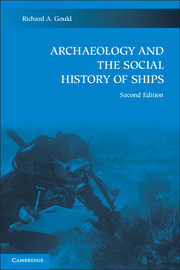Book contents
- Frontmatter
- Contents
- List of figures
- List of tables
- Acknowledgments
- Introduction: Toward a higher standard
- 1 Interpreting the underwater archaeological record
- 2 Underwater archaeology: The state of the art
- 3 Ships and shipwrecks: Basic mechanics
- 4 The archaeology of small watercraft
- 5 The earliest ships
- 6 Shipwrecks and our understanding of ancient trade
- 7 Sailing ships of the Middle Ages
- 8 Ships of the great age of sail
- 9 From sail to steam in maritime commerce
- 10 New technologies and naval warfare
- 11 The archaeology of maritime infrastructure
- 12 The future of shipwreck archaeology
- References cited
- General index
- Ship and site index
3 - Ships and shipwrecks: Basic mechanics
Published online by Cambridge University Press: 05 June 2012
- Frontmatter
- Contents
- List of figures
- List of tables
- Acknowledgments
- Introduction: Toward a higher standard
- 1 Interpreting the underwater archaeological record
- 2 Underwater archaeology: The state of the art
- 3 Ships and shipwrecks: Basic mechanics
- 4 The archaeology of small watercraft
- 5 The earliest ships
- 6 Shipwrecks and our understanding of ancient trade
- 7 Sailing ships of the Middle Ages
- 8 Ships of the great age of sail
- 9 From sail to steam in maritime commerce
- 10 New technologies and naval warfare
- 11 The archaeology of maritime infrastructure
- 12 The future of shipwreck archaeology
- References cited
- General index
- Ship and site index
Summary
As a historical science, shipwreck archaeology requires some basic understanding of the physical relationships between ship design and construction and the medium in which voyaging occurs. It also requires an organized approach to the physical context of the wreck – both the factors leading to the loss of the vessel and the factors that have affected the condition and distribution of wreck materials at the site. Many such relationships operate according to uniformitarian principles – that is, they can be assumed to have operated in the past in the same manner, though not necessarily at the same rate, as they do today.
Any ship other than a submersible operates simultaneously and continuously in two media, the sea and air, while avoiding contact with a third, land, except under specific conditions like docking or beaching. The combination of sea and air environments, fluid and ever changing, dominates all maritime activities. Each of these media independently affects the movements of a ship at sea. A vessel approaching a dock on a windy day, for example, with a current moving in one direction and a wind from another at different velocities is affected differently above and below water by each. Docking under such conditions requires a high order of skill and experience, and the ship's ability to maneuver and change speed is critical.
Sea and air environments also interact in complex ways.
- Type
- Chapter
- Information
- Archaeology and the Social History of Ships , pp. 63 - 90Publisher: Cambridge University PressPrint publication year: 2011



